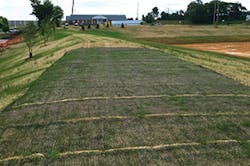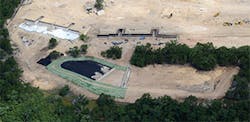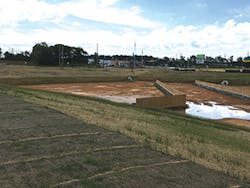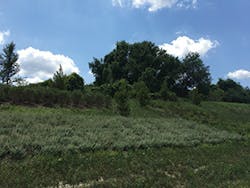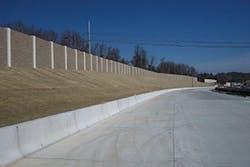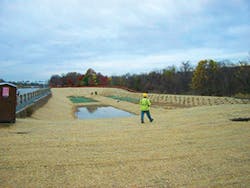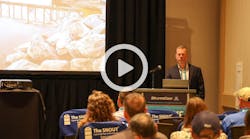Twenty years ago my brother and I started out as small excavating and general contractors,” says Chauncey Webster, president of East Coast Green Inc., in St. Thomas, PA. “Gradually we leaned more and more toward erosion control work.”
East Coast Green works in south central Pennsylvania as well as West Virginia, Virginia, Maryland, and occasionally Delaware, New York, and New Jersey. The company does erosion control work, hydroseeding, and landscaping on commercial and residential projects.
Curlex installed around a stormwater pond at Steiner Ranch
“We have a fairly large footprint,” says Webster. “The company is doing more commercial than government work now, but that will swing, I’m sure.”
East Coast Green is currently working on a project in Carlisle, PA, on a site where four warehouses are being built. The warehouses range from 450,000 square feet to more than one million square feet. Work on the project includes controlling erosion while construction goes on and revegetating the disturbed soil around the finished buildings. Two items East Coast Green has used on this project include SiltSoxx from Filtrexx Inc. of Akron, OH, and Soil Guard from Mat Inc. of Floodwood, MN.
The warehouse site
Soil Guard is the only bonded fiber matrix (BFM) whose manufacturer requires that it be applied by certified applicators. Hydraulically applied, Soil Guard conforms to the contours of the ground. Once dry, it will hold soil and seed without washing away. As vegetation takes hold, Soil Guard slowly decomposes to enrich the soil.
Webster says that the Soil Guard was applied at the rate of 3,750 pounds per acre. The two-man crews used two T330 Finn HydroSeeders. The company also owns a Finn HydroSeeder model T120.
“We used a couple of tractor-trailer loads of material,” says Webster. “Each machine sprayed six to eight loads per day, so we got two and a half acres out of the two-man crews.”
Webster has been using Soil Guard for 15 years. “It’s highly effective and very time-effective compared to traditional matting,” he says.
Work on the warehouse project started in April 2016. Completion is scheduled for fall of this year.
“There are time constraints. We have to meet State [of Pennsylvania] Department of Environmental Protection requirements and ensure a window of good germination time,” explains Webster.
The seed mixtures vary at each warehouse location. They include a meadow mix, low-maintenance mix, native grass mix, and finished lawn mix for sections most visible to the public. Native grasses planted at the project site include bluestem, switchgrass, and little bluestem. Some locations required a nurse crop of rye grass or oats. The low-maintenance and lawn mixtures don’t need any nurse crop seeds.
The meadow mixture consists of native species of grasses and wildflowers. These wildflowers include black-eyed susan, coneflower, milkweed, and ironweed.
“There’s a big push on native plants at this moment,” notes Webster. The seed mixtures selected for the areas around the warehouses varies. “They were not all one type per warehouse. There were sometimes three or four types around the same warehouse,” says Webster
He notes that on this job, as in any erosion control work, “weather is always a factor. It’s off or on. We’ve had rainy spells and dry spells, but nothing had to be done over. Everything we applied held up.”
Fertilizer added around the various warehouses also varies. Tackifier was not needed because the Soil Guard already includes it.
Reflecting on his years of performing erosion control work, Webster says, “No job is alike; every job is unique. You’re always dipping into resources, finding products that are the most effective for the project. Nothing surprises us anymore.”
Revegetated slope near State Route 202
State Route 202
Located in West Chester, PA, Ram-T Corporation is a full-service erosion control, hydroseeding, and landscaping firm working in Pennsylvania, New Jersey, and Delaware. What’s not typical in the field of erosion control is that Deborah Turner and her daughter Ashley Kreutzer own Ram-T. Turner and her brother-in-law, whose last name is Ramirez, founded the firm. The company’s name comes from a combination of the founders’ names: the first three letters of Ramirez, and the T for Turner. Turner kept the name after her brother-in-law left the company.
Kreutzer grew up watching her mother at work in a male-dominated field. She chose to study fashion design in college and worked in the industry in New York City. It wasn’t as ideal as she expected, though, so she returned to Ram-T and focused her creative ideas on landscape design projects.
Along State Route 202 in Pennsylvania
Gradually Kreutzer learned from her mother and other Ram-T employees how erosion control work is done. Many of the employees have been with the firm for 20 years, so they have a lot of expertise to call on.
These days Turner focuses on the financial side of the business and long-term plans. Kreutzer, as general superintendent and vice president of operations, manages the daily demands of fieldwork from working with contractors, to scheduling crews for jobs.
“Our SR [State Route] 202 project is one of the largest ones we’ve done. It’s a major roadway, and Penn DOT [Pennsylvania Department of Transportation] breaks it down into two separate projects,” says Kreutzer. “We worked with two different contractors on the two different sections.”
The two general contracting firms are R.E. Pierson Construction Company of Pilesgrove, NJ, and Allan Myers of Worcester, PA. Ram-T is responsible for all of the erosion control work needed on this project, covering a total area of more than 15 acres.
SR 202 runs from Exeter to King of Prussia, PA. The heavily traveled road is a major thoroughfare and needed to be widened and renovated.
Ram-T began working on the project in 2012, “and we’ll close it out this year,” says Kreutzer. “At one time we had five crews working at once on different projects [within the overall job]. That changes day to day.”
She says the most challenging part of this major project is access. “The road had to remain open. We had a lot of different traffic patterns, a lot of lane closures.
“We had to get very creative in getting our materials in. We can’t get trucks close to trees, so we had to move material by hand. Access has been a challenge throughout the project.”
Working year around in Pennsylvania’s four-season climate has also brought challenges for Ram-T’s crews. “The winter of 2014 was very bad. The entire project shut down for two months. Our primary contractor could do little work in January and February. Every four days or so, we were getting snow, and the temperatures ranged from zero to 20 degrees,” recalls Kreutzer.
The SR 202 project is being done under the increasing regulations on federal, state, and municipal levels, typical of major erosion control projects today. Documenting the firm’s compliance with these regulations falls to Kreutzer. “The paperwork on this project is not for the faint of heart,” she declares.
“The primary contractors have held us to high standards,” she notes. “There are scheduled and unscheduled inspections weekly. Sometimes work has to happen quickly to meet their standards. We may have a limited time frame to get a large area covered to avoid [damage or erosion from] weather.”
Doing erosion control work on multiple and different sections of this big Penn DOT project, and keeping the site in compliance despite weather changes mean that “we need to be set up for dispatching crews at the last minute,” says Kreutzer.
Slope angles and heights vary on this large site, too. “Some areas are very steep, especially above where retaining walls are, so access was tricky. There was a safety risk for the workers, so they needed to wear harnesses to install materials there,” says Kreutzer.
Other sections had “two-to-one slopes, moderate. Heights vary from 10 feet to 100 feet,” she adds.
Seed for the project is Penn DOT’s Formula L, a seed mixture for slopes. It is a lower-maintenance and slow-growing mixture. The main native grass in the seed mixture is fescue with a small amount of rye. No wildflower seeds were included.
Blankets were an essential part of the erosion control measures. “On 90% of the project we used East Coast Erosion Control blankets,” says Kreutzer. “We put S-1 type [a short-term, biodegradable blanket] on the majority of it, and P-2 [a permanent polypropylene turf reinforcement mat] on basins, mitigation areas, spillways, and swales.”
Ram-T uses East Coast Erosion Control’s blankets often. On this large project Kreutzer says they’ve used “acres and acres” of these blankets.
After Ram-T did erosion control work on designated sections of the SR 202 project, the firm continued with landscaping. “We were able to do both landscaping and erosion control for our primary contractors,” says Kreutzer.
The company even did a bit of construction work. This involved installing concrete block revetments in the bottom of swales. Hydroseeding was done using Profile Products’ Flexterra where needed.
Kreutzer explains that the landscaping done on the project was for two reasons. “In addition to beautifying the roadside, the government was overseeing post-construction stormwater management. Specifications said that the trees that had been removed for construction needed to be replaced and reforested.”
The replacements for the trees that were removed were “thousands of seedlings of native trees—upwards of 20,000 plants along the roadway to help with stormwater runoff.” The seedlings included various species of oak and maple trees. When these seedlings grow into mature trees, drivers on this busy road will see a restored forest.
Blankets and new plantings around a stormwater basin
Reflecting on how erosion control work has evolved, Kreutzer says, “what an important part of the construction process erosion control has become. All that paving and concrete means you don’t have grass growing. The work comes down to landscaping and grass. They have to be growing and healthy before the project can be closed out.”
A High-Profile Job in Oregon
Fox Erosion Control and Landscaping in Clackamas, OR, uses Profile Products’ Flexterra on many jobs. The product was an essential part of a particular highway project that Fox did, along with general contractor Wildish Standard Paving of Eugene, OR.
“This was the first project where we had an opportunity to introduce Flexterra High-Performance Flexible Growth Medium to ODOT [Oregon Department of Transportation],” says Terry Marsh, president of Fox.
The work involved a change order project on the south west Iowa Street Viaduct Bridge over Interstate 5 in downtown Portland, OR. The location was close to an affluent neighborhood.
“There were lots of slopes; steep terraces had been opened up. Lots of people were complaining and lots of people were watching the project. Their homes are nice, and they were very concerned about runoff, dust, and silt getting into nearby streams and fish hatcheries,” explains Marsh.
The residents were concerned about dirt—which the Oregon rains would quickly turn into mud. The site was an eyesore and, given the steep terrain, a potential environmental problem.
Straw to cover the soil would have been cost effective, but “they didn’t want us to use straw because it would be blown over the neighborhood,” says Marsh.
Something was needed to prevent dust or soil leaving the site because of rain or wind, to keep adjoining private properties clean, and assuage environmental concerns. Whatever was used had to cover the soil and also have an acceptable appearance.
“Every Friday before the project shut down for the weekend, any open soil we saw, we would cover it with Flexterra,” says Marsh.
The total area covered with Flexterra was about four acres. The product’s overall green appearance was acceptable, and provided a visual assurance that the contractor was protecting the environment and the residents’ homes.
Marsh says that Flexterra worked perfectly. “That one project opened the door to ODOT taking a serious look at the product at the state and the county level. That one project changed a lot of people’s minds about Flexterra as a replacement for erosion control straw mats.”
The crews shot the Flexterra from a Finn T330 HydroSeeder. Marsh says that people often ask if Flexterra mixes well in a hydroseeding machine and if it can be applied when the weather is rainy or misty. “Because it’s a long wood fiber, rather than a shorter fiber, and because it has an aggressive tackifier, it mixes up into a pretty viscous mixture. You can’t mix up as much as you can with regular fiber mulch, so you’ll be doing more applications to get out the same amount,” he notes.
As for using Flexterra during wet weather, “we can shoot when it’s raining, as long as it’s not pouring. With a drizzle it sets itself up well.”
Noting the differences in tackifiers, Marsh says, “Flexterra seeps down into the soil and helps the product to secure itself to the soil, rather than to secure it to itself.”
He feels that the project showed that Flexterra, even though more expensive than straw, “could be done expeditiously, whereas using straw was labor intensive, with higher labor costs.”
The I-5 project started in July 2010, and lasted until October 2014. Some sections were covered with Flexterra multiple times to stabilize soil that had been disturbed since the previous week’s covering. By the completion date, Fox had shot enough Flexterra to cover 26 acres.
Marsh says that rain is usually a factor on projects. “Oregon gets its fair share year around. In the coastal mountains, it’s 80 inches of rain annually. In the Willamette Valley where Portland is, it’s 40 to 50 inches a year.”
Besides wet weather, “traffic was a significant issue. We always had to contend with heavy traffic. I-5 is the largest freeway, and the most traveled in the state of Oregon,” he adds.
Heavy traffic affects access, so workers and materials can take longer to travel to and from the site. “There were long loops we had to make if we were shooting more than one area.”
The Fox crews had to wait on Fridays for all of the other work on the site to be finished, and that put them squarely into general rush-hour traffic. “We didn’t finish on Fridays until seven or eight at night,” recalls Marsh.
For the final hydroseeding on the project, Fox used mycorrhizae at 10 pounds per acre, Flexterra at 3,000 pounds per acre, and seed at 80 pure live seed (PLS) pounds per acre. The seed mixture, from Sunmark Seeds of Portland, included California brome, blue wild rye, pearly everlasting, and white yarrow.
State Route 202
On a few projects, Marsh has used Profile Products’ CocoFlex. He uses Flexterra more often, he says, “because it’s wood fiber and will break down. CocoFlex doesn’t break down as readily.” The Extended Term-Flexible Growth Medium includes coir and wood fibers.
In 2014, Fox performed erosion control on a slide on Highway 26, near the Portland Zoo. The slope was covered with ivy, which takes in moisture during the winter, freezes, and then expands, causing problems. Some parts of the slope were vertical, making access very difficult.
“We were in a boom, like a cherry picker, raised up and down to have access in a safe way,” recalls Marsh.
Once the CocoFlex set, it stayed secure, even on such a severe slope. Marsh says the area revegetated well. The soil on the site contained large rocks. Marsh says that the CocoFlex attached itself so well that seeded grass even grew on the rocks, until it dried out with summer heat.
Fox does industrial landscaping, as well as irrigation work and erosion control. Marsh started in industrial landscaping, but wanted to be able to work in another field where there is less competition.
Tacara at Steiner Ranch
Environmental Allies provides erosion control and stormwater services, including developing stormwater pollution prevention plans (SWPPPs), filing permit applications, installing sand filtration ponds and other BMPs for erosion and sediment control, hydroseeding, and establishing and maintaining turf.
Founded in 1999, Environmental Allies has offices in Houston and Austin, TX. The company works on commercial, governmental, and residential projects throughout the state.
Andy Dean is senior project manager and Katrina Wood serves as director of business development for the firm.
Environmental Allies is currently doing erosion control and related work on an interesting project with Baxter Contracting of San Antonio as the general contractor. The Tacara at Steiner Ranch is a luxury apartment complex 17 miles northwest of downtown Austin.
Steiner Ranch is a new community being developed on 4,600 acres that was once ranchland owned by the Steiner family. The Tacara development is being built on 60 of those acres.
Wood says the community has fabulous views overlooking nearby Lake Travis. Steiner Ranch is being developed as “a centralized community, with shopping close by.”
Environmental Allies has been working on this project since September 2015. Ground was broken on the project in October 2015. Dean says that completion is scheduled for some time during summer 2017.
Two adjacent ponds—one for detention and one for infiltration—form a significant sediment and erosion control BMP on the property. The filtered water is discharged on the property; some infiltrates back into the ground and some flows to the nearest natural waterway.
To protect the ponds, an erosion blanket of Curlex Type 1 was installed around its perimeter and up the surrounding slopes. Curlex blankets, made by the American Excelsior Company of Arlington, TX, consist of long aspen wood fibers. The fibers adhere to the ground, soak up and retain moisture to help vegetation germinate and grow, and then biodegrade.
“We install Curlex on many of our projects,” says Dean. “The majority of our projects involve sediment or temporary erosion control.”
Installing the Curlex around the stormwater ponds took a five-man crew only two days. “Our guys are experienced, and as long as the contractor has everything graded for us, they can knock the work out pretty quickly,” says Dean. “There’s one acre of Curlex installed around the eight-and-a-half acre pond.”
Work on the pond was finished in May. The surrounding land is “sloping down to the pond to where we could do the ‘walkable and workable’ test,” says Wood. “It’s three-to-one or less, and safe for the workers.”
When construction on the Tacara project is finished, Environmental Allies will do the final seeding for revegetation of the grounds. Curlex will be used again to help the permanent vegetation get established.
“We have to time it just right,” explains Dean. “There’s a narrow window for permanent seeding [before the weather gets too hot].”
Stabilization surrounding the apartment complex will be mainly Bermuda grass seed.
“Bermuda is the most common grass here because it is heat resistant and it doesn’t need a lot of water. When the spec calls for it, we will put in some other native grasses, too,” says Dean. “Our biggest road block is the terrain—it’s so hard and dense. We have to bring in topsoil and regrade.” The Environmental Allies crews will put in 4 to 6 inches of topsoil that is a blend of sand, loam, and compost material.
Dean adds, “Central Texas is notorious for rocky soil. We’re lucky if there are six inches of soil we can work with. Then we start running into limestone under the soil.”
The City of Austin pays close attention to protection of trees and other environmental features on projects such as this one. City inspectors had to monitor the pond installation and will continue to check on other parts of the project that could have a negative impact on the environment.
Austin’s hot, dry climate means that its underground aquifers are a precious resource. On every project, “the aquifers have to be addressed,” notes Dean.
Wood says Austin’s environmental regulations are so stringent that the state’s Department of Environmental Quality “leans on this public entity [and others].”
“Austin is a leader in erosion control compliance,” says Dean. “A lot of cities in Texas piggyback off of its regulations and follow what Austin is doing.”
